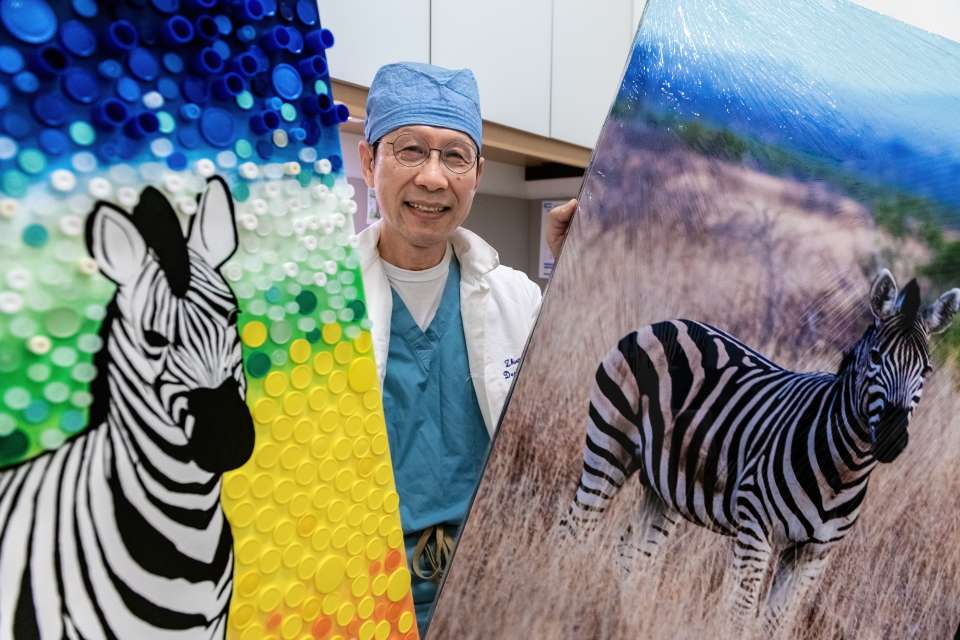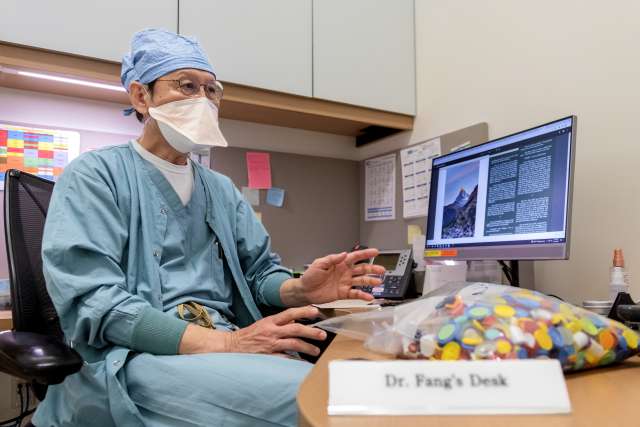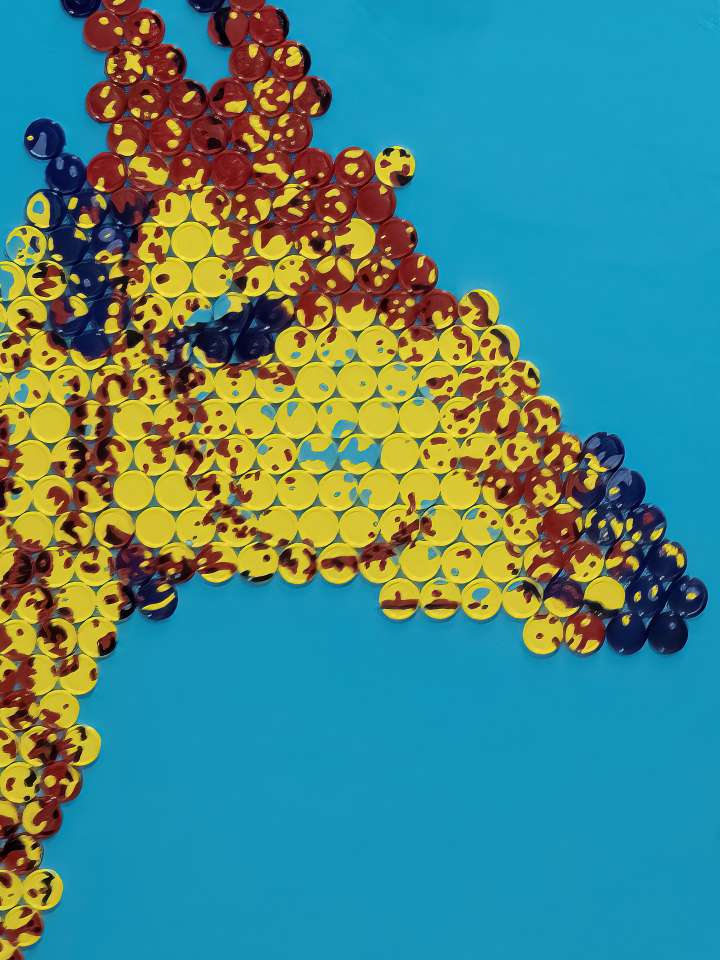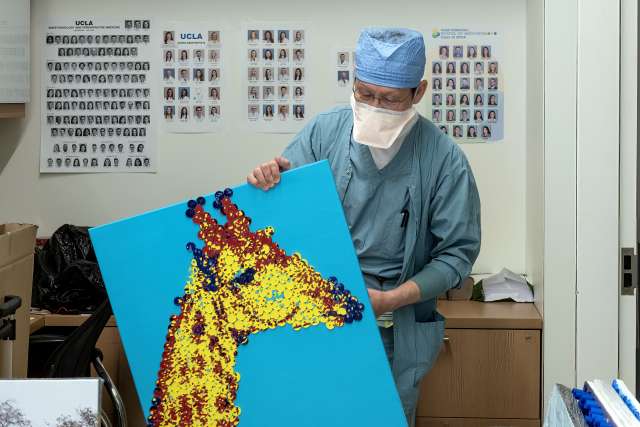It started with a desire to be more environmentally conscious, by diverting plastic waste from landfills.
Anesthesiologist Zhuang T. Fang, MD, and nurse Cody Kaufman, MSN, RN, in 2021, started collecting the hundreds of discarded plastic caps from vials of propofol, lidocaine, midazolam, ondansetron and other anesthetics used in the operating room each day.
The co-workers at the UCLA Stein Eye Institute wanted to be more environmentally sensitive. And before long, they’d filled dozens of giant Ziploc bags with thousands of red, yellow, orange, green and blue plastic circles.
Both artists in their free time, they wanted to turn these caps into something beautiful, says Dr. Fang, interim medical director of the Stein Eye Institute and a clinical professor at the David Geffen School of Medicine at UCLA.
Considering the toll the COVID-19 pandemic had taken on health care workers, Dr. Fang thought his colleagues might find the opportunity to make art deeply therapeutic.
“Just creating that art piece is a process to bring some peace, some happiness and some joy,” he says. “Also, sharing the final products brings things to another level.”
Dr. Fang, an accomplished nature photographer, has captured breathtaking images during his travels around the world. He offered his own photos as inspiration for the medicine cap artwork as he recruited medical residents and nurses to join in the process. Dr. Fang had his photos printed on 24-by-36-inch canvas and provided his artists with blank canvases the same size.

Now, two years later, the slate of artists has completed three mosaics and 10 more are in the works. Dr. Fang envisions a public exhibition to not only display the creations but inspire other UCLA Health departments to do some upcycling of their own.
“We can give people some ideas and get more people involved,” he says. “I think that would be another way to recycle our wasted material and turn it into something beautiful.”
Bonding over art
Dr. Fang says art has long helped him bond with patients.
As an anesthesiologist, he only has a few minutes with each patient before they have eye surgery, and they’re generally “super, super nervous,” he says. In his view, part of his job is to help them feel at ease even before he administers anesthesia, so he likes to chat with patients, and one of his favorite topics is photography.
“My photographs are actually a very good way, an effective tool to connect with patients,” he says. “We have a lot of artists (as patients). We have painters, sculptors, acting, all kinds of art forms. And I found that when we can share a common interest or a common appreciation of art, it builds trust. We feel like we have something in common we can share together, and that really makes the conversation much easier.”
Dr. Fang also had shared his photographs with colleagues for years, donating framed photos to UCLA Santa Monica Medical Center a decade ago. But the medicine cap project brought new depth to the artistic conversation.
When they had a few free minutes during rotations, Dr. Fang would ask his colleagues, “Are you doing art? Are you doing any painting?”
“That’s how it started,” he says. “Then I’d recruit them.”
As a post-anesthesia nurse, Kaufman regularly collaborates with Dr. Fang on patient care. But teaming up on the art project added a new dimension to their relationship, Kaufman says.

“It’s almost on a more personal level, because we get to see a reflection of his creativity and insight into his life,” Kaufman says. “He tells us stories about where he’s been and the stories behind the photos, so you definitely connect on a deeper level than clocking in and clocking out.”
Bringing depth to art, work and life
When Kaufman started collecting the medicine caps, he knew he wanted to make something out of them, but he wasn’t sure what. Once Dr. Fang offered up his photos as inspiration, the vision clicked.
“I wanted to make the project more personal, so I picked some pictures that might be easy to recreate with the caps,” Dr. Fang says.
Kaufman chose a giraffe photo that Dr. Fang took while on safari in South Africa.
Kaufman used his computer to zoom in on the head of the giraffe and built a template for how it might look with the caps filling the image. He spent hours separating the caps by color and size so he knew what he was working with. He custom-mixed paint to match the color of the caps.
He worked on the project with his girlfriend, Joanna Franco-Perez, RN, who scrupulously painted the caps to match the template design.
“Collaborating with Joanna has not only enhanced our work but also strengthened our bond, much like the collaboration between Dr. Fang and me,” Kaufman says.
Then he painted the canvas, transferred the template and methodically built the mosaic.
“It’s very numerical and systematic with the positioning of the caps,” he says.
On occasion, when he and Dr. Fang were working late, they’d talk about the project and Kaufman’s progress.
“Cody, at the beginning, said, ‘This is very difficult. This is very, very challenging.’ I could tell he’s so meticulous. He wants to do things so precise,” Dr. Fang says. “When I heard he was using Photoshop to scan the giraffe, I knew I was getting a masterpiece, a beautiful masterpiece. I just kept encouraging him and saying, ‘You know, you don’t have to be that precise,’ because I didn’t want him to quit!”

Dr. Fang says he was “in shock” when he saw the finished piece, which took Kaufman about 30 hours to create. The mosaic replicates the giraffe in the photo exactly, right down to its spots.
The other completed medicine cap mosaics include a zebra standing in a savanna, by resident Emerly Luong, MD, and a stunning shot of a sunrise on the Matterhorn in Switzerland, by resident Kathy Cazares, MD.
Dr. Fang’s artists continue to work on their mosaic interpretations of a national park in China, Mount Rainier in Washington and rock formations in Arizona. Meanwhile, Kaufman is applying his meticulous approach to an image of Machu Picchu.
Kaufman sees the patients they care for reflected in the art pieces.
“Every single cap here is involved in the anesthesia of a different patient,” he says. “Combined, probably thousands of patients are represented.”
Dr. Fang is so impressed by the creations that he can’t wait to share them with a broader audience, at UCLA and beyond. He’d love to have all 20 pieces — the original photos and their mosaic counterparts — framed and displayed in an exhibit before finding a permanent home, he says, maybe somewhere in the hospital.
“I am so happy and just fascinated” with the medicine cap mosaics, Dr. Fang says. “These are beyond my imagination.”




